Nail the Dumbbell Shrug for Bigger, Broader, Boulder Shoulders
If you have goals of building bigger shoulders and a wider back, training your traps needs to be central to your workouts. The traps (trapezius muscles) span from the middle of your back and neck to your shoulders, and the best way to target them is to learn how to do the dumbbell shrug.
‘A lot of the time guys talk about wanting bigger shoulders, and when we talk about that, we’re talking about working our delts. But that’s not the only part of your shoulders that you want to train. If you want that good 3D look, you’ve also got to spend some time training up your traps’ according to Men's Health US fitness director Ebenezer Samuel.
If you want to follow Samuel's advice and train your traps, include shrugs in your next workout. But before you rush off to grab a set of dumbbells, allow us to walk you through how to do the dumbbell shrug, as well as explain what muscles you'll be working and how to progress from the basic shrug with variations.
Muscles Worked in the Shrug
Before we nail your dumbbell shrug form, let's go through the muscles you'll be working. For those of you who like to skip leg day, you're in luck.

Trapezius: The primary muscle worked by the dumbbell shrug. Focus on squeezing the traps up and back to ensure you keep the shoulders from rounding.
Rhomboids: As you shrug the traps, the rhomboids are activated and support the shoulder blades to slide upwards.
Forearms and Grip: Your forearms and grip will be working hard to hold onto the dumbbells for the entirety of the set. If grip strength is your focus, shrugs are a great choice of exercise.

The Benefits of Dumbbell Shrugs
Doing dumbbell shrugs and building stronger traps has a performance benefit and will improve your deadlifts, carries, overhead press, rows and pull-ups to name a few. Evidence also suggests that dumbbell shrugs could be beneficial in relieving neck pain. The shrug is easy to do, so should you be a beginner and have a set of dumbbells, you can give this a go from the comfort of your home.
The dumbbell shrug requires good technique in order to get the most out of the exercise and also to protects your shoulders from injury.
According to Samuel, ‘Bro science [or at least some of it] states that you should look at the ground when you’re shrugging. In theory, you work the traps through a fuller range of motion by doing this. Don’t fall for it, though.’
Here is the right way to do it, bro-science free.
How to Do the Dumbbell Shrug
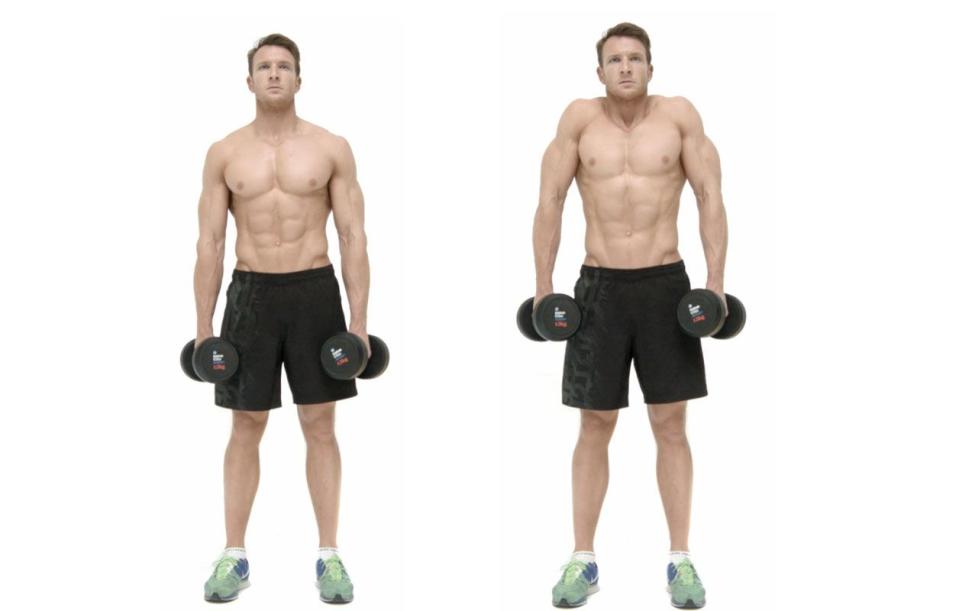
Begin with your feet underneath your hips, standing tall with the dumbbells at your sides and palms facing inwards (neutral grip).
Engage your core by drawing your belly button to your spine.
Initiate the movement by drawing your shoulders upwards while keeping the chest open and chin in place. Avoid rounding the shoulders and jutting your chin forward.
Lift the shoulders to the end of your range of movement, this is very individual so it’s important to work within your capabilities.
Squeeze the traps at the top of the movement for a beat and then reverse the movement slowly. This ensures the reps are controlled and maximises on the eccentric (downward) portion of the rep.
How Many Reps and Which Weight Is Best for Dumbbell Shrugs?
Choose a rep range and weight to suit your abilities. As a general rule of thumb, for dumbbell shrugs, four sets of 12-15 reps with a pair of light to moderate weights should be sufficient for building muscle.
To choose an ideal weight, familiarise yourself with the RPE scale (rate of perceived exertion). This is a scale from one-to-10, 10 being maximum exertion, one being minimum exertion.
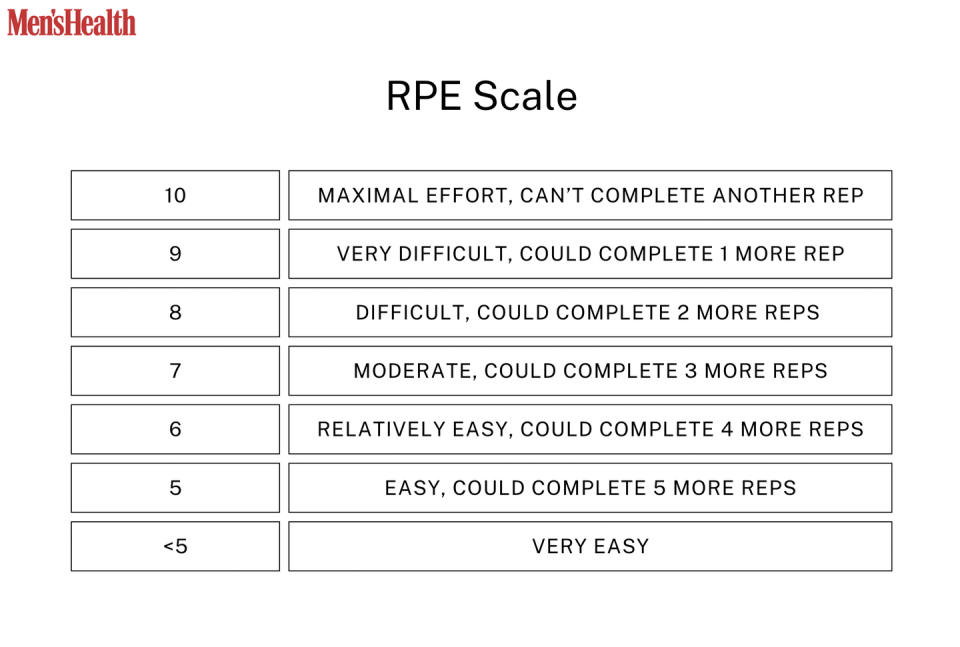
For strength and muscle gain, towards the end of your sets, ideally you want to be sitting at around an eight out of 10. This means that at a push you could complete two more reps at the end of the set with your weight of choice.
Shrug Variations

Barbell Shrugs
With the barbell shrug there is one main difference, your grip will be pronated (palms facing away from you) instead of neutral. However, this doesn’t mean you can’t keep your chest open and complete the reps with good form. Begin by deadlifting the bar up so you are standing straight with the bar in front of you. Imagine breaking the barbell by pulling your shoulder blades back before completing the rep. Raise your shoulders upwards while keeping your head in line. Squeeze the traps and reverse the movement back down, slowly and under control to prevent jolting.
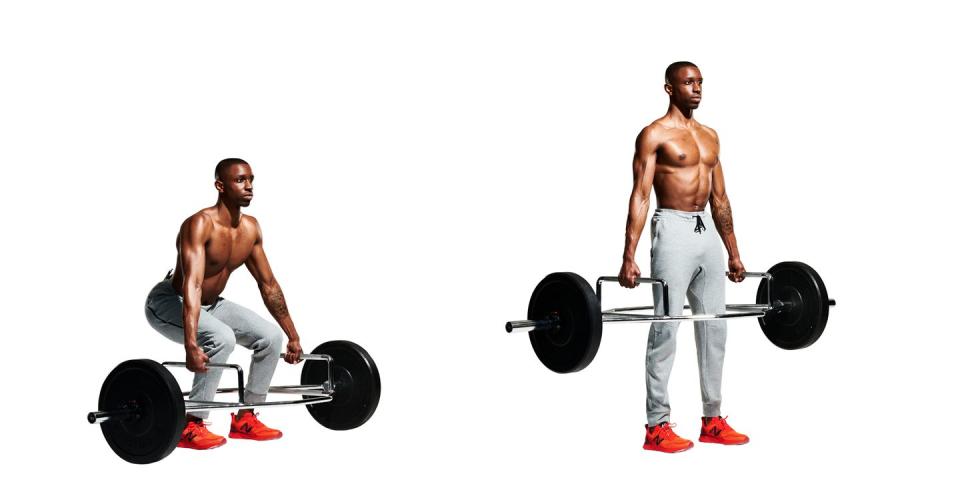
Trap-Bar Shrugs
Trap bar shrugs are preferable to barbell shrugs due to the nature of the handles being at your sides, lending itself to a neutral grip. It’s also beneficial to be able to load the weight equally around the body in order to encourage standing tall instead of leaning forward. Start by deadlifting the trap bar up so that you are standing tall. Lift the shoulders upwards so that you engage your traps at the top of the movement. Hold for a beat and then reverse.
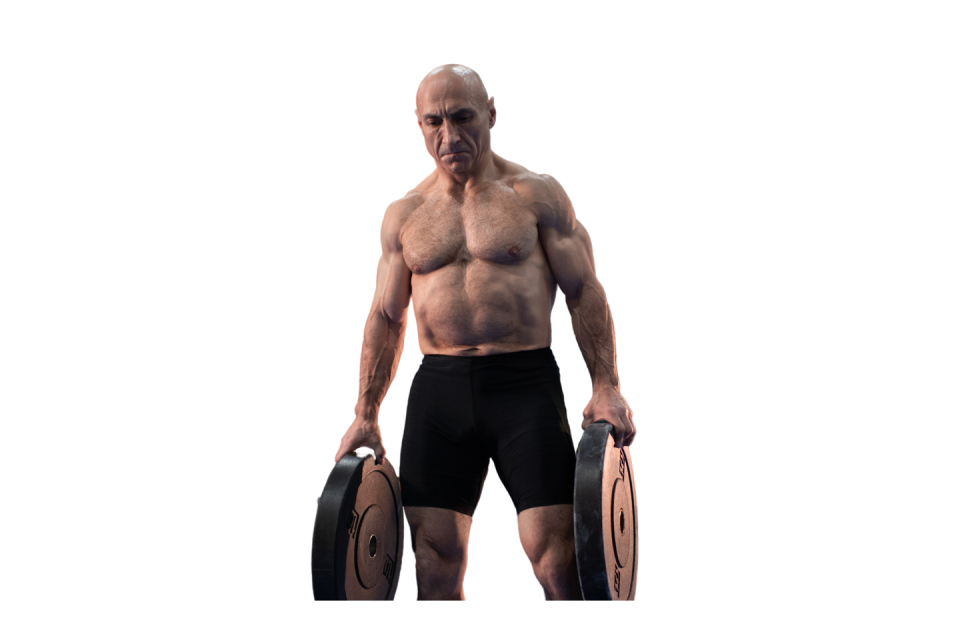
Plate Pinch Shrugs
Plate pinch shrugs deliver double the gains for the price of one exercise. You'll get some additional grip and forearm strength from your shrugs, while still hitting the shoulders. Grab a pair of plates in each hand between your thumb and fingers and stand tall with your feet under your hips. Shrug the shoulders upwards while keeping the chest open and chin in place. Squeeze the traps at the top of the movement for a second and then reverse the rep slowly.
Single-Arm Shrugs
Very similar to the dumbbell shrugs, the single arm shrugs just work one side. This challenges your core a little more so that you resist bending sideways. Begin with the dumbbell at your side, keep your core engaged to avoid any side lean. Shrug one shoulder upwards whilst keeping your entire torso still. Slowly lower the dumbbell back to your side.
The Best Shoulder Workouts
Back and Shoulders Workout for Massive Wings and Bigger Delts
Build Boulder Shoulders with Just One Dumbbell and One Movement
Back, Shoulders and Arm Workout That Got Chris Hemsworth Furiosa Ready
Dumbbell Shrug Workout
Now you know how to perform the dumbbell shrug with perfect technique, give this shoulder workout a go.
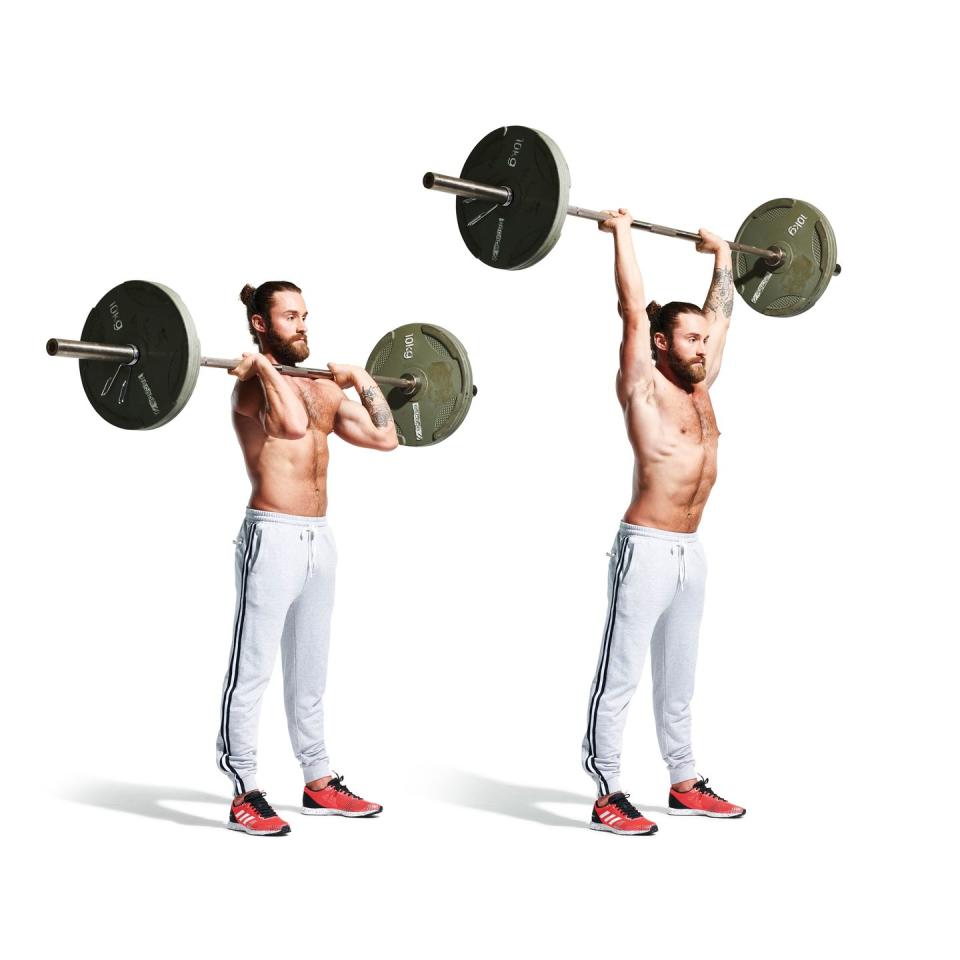
Strict Press x 6-10 reps, 2-4 sets
Clean your barbell to the front rack position with your elbows lifted. Take a breath and brace your core. Drive your barbell directly overhead until the elbows lock out. Avoid arching your back throughout the rep. Lower under control.

Dumbbell Shrug x 12-15 reps, 3 sets
Begin standing tall with the dumbbells at your sides and palms facing inwards (neutral grip). Engage your core and initiate the movement by drawing your shoulders upwards while keeping your chest open and chin in place. Lift your shoulders high and squeeze the traps at the top of the movement for a beat and then reverse the movement slowly.
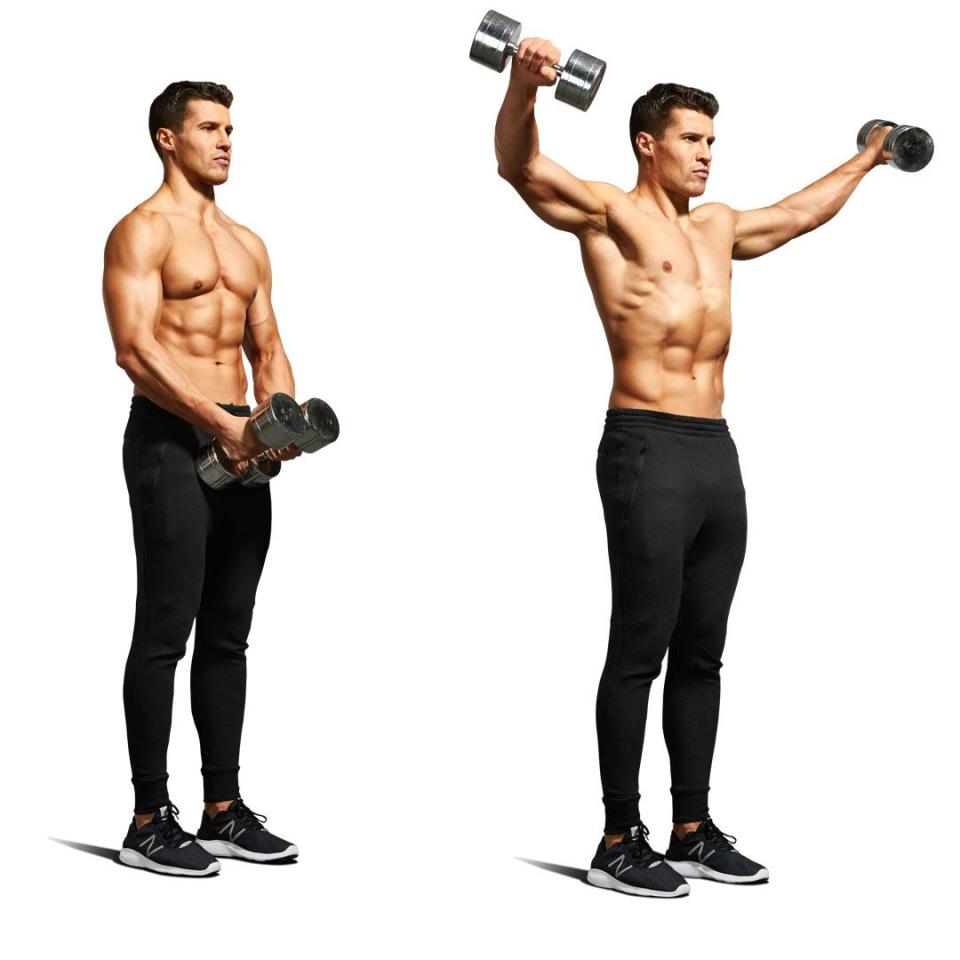
Lateral Raise x 12-15 reps, 3 sets
Grab a couple of dumbbells and stand with them by your sides, with your palms facing your body. Stand tall with your core switched on and shoulder blades pulled back and down. Keeping your back straight, and your upper body still – that means no swinging – lift the dumbbells out to your side with a slight bend at your elbows, keeping the weights higher than your forearms. Lift until your arms are parallel to the floor, then slowly lower to the start position.
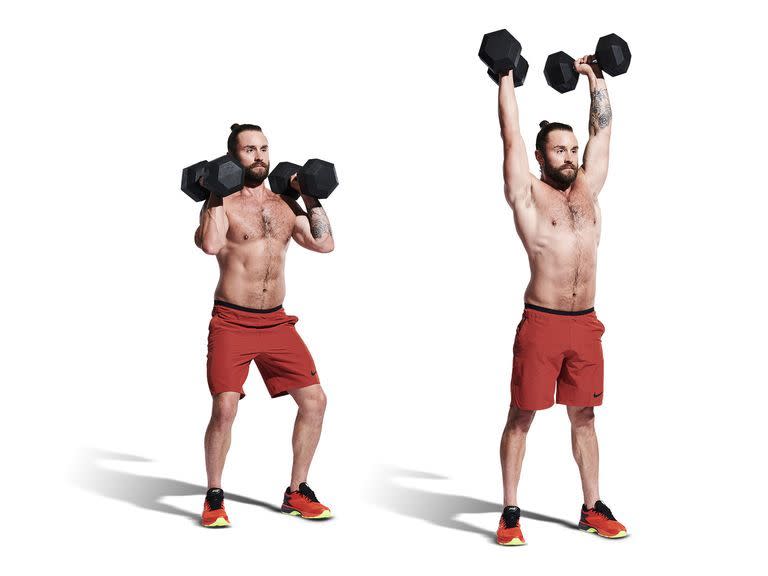
Push Press x 10-15 reps, 3-5 sets
Pick a lighter weight than you would use for your dumbbell strict press and keep the rest periods swift. Lift the dumbbells onto your shoulders, palms facing inward. Dip at the knees and use your legs to help press both dumbbells overhead. Pause for a breath at the top before lowering the bells slowly and under control to your shoulders. Repeat.
You Might Also Like


